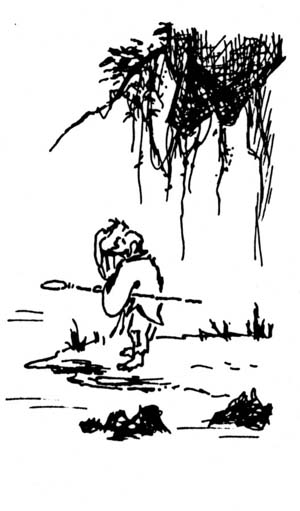|
||
 |
||

(C)2001 Japanese Architecture and Art Net Users System. No reproduction or republication without written permission.
掲載のテキスト・写真・イラストなど、全てのコンテンツの無断複製・転載を禁じます。
|
||||||
| Kensu 蜆子 | ||||||
| KEY WORD : art history / paintings | ||||||
| Ch: Xianzi.
A semi-legendary 9c itinerant priest and eccentric. His name, meaning something
like "Clam Priest," is derived from his practice of spending his days wandering
along river-banks eating crayfish and clams. Although this practice is in conflict
with the Zen 禅 (Ch: Chan) insistence on a strictly vegetarian diet, one story
has it that Kensu achieved enlightenment while catching a shrimp. However, eccentrics
who disobeyed Buddhist law to follow their own natures were often greatly respected.
The earliest description of Kensu is found in the Record of The Transmission of
The Lamp (Jp: KEITOKU DENTOUROKU 景徳伝灯録, Ch: Jingde Chuandenglu) of 1004
which lists him as a disciple of priest Dongshan (Jp: Dousan 洞山; 807-69), one of the founders
of the Soutou 曹洞 sect of Zen. Some scholars, however, are wary of this claim,
and feel Kensu had no firm affiliation with an established order. Kensu reportedly
lived near the White Horse Temple (Ch: Baimasi, Jp: Hakubaji 白馬寺) on Mt. Dong 東. In painting,
he is usually depicted wearing ragged clothes, holding a crayfish in one hand
and a net in the other. Images of Kensu are frequently paired with Zen eccentric
*Chotou 猪頭, who is always
represented carrying a boar's head. Typically, Kensu's hair is long and sparse
and he bears a beatific grin. Among the best-known paintings of the subject are:
those attributed to Muqi (Jp: Mokkei 牧谿, Private collection in Japan); by Kaou
可翁 (act. mid-14c; Tokyo National Museum); and Hasegawa Touhaku 長谷川等伯 (1539-1610; Daitokuji Shinjuan 大徳寺真珠庵, Kyoto). |
||||||
 |
||||||
| REFERENCES: | ||||||
| EXTERNAL LINKS: | ||||||
| Kensu Oshou-zu 蜆子和尚図 at Tokyo National Museum | ||||||
| NOTES: | ||||||
(C)2001 Japanese Architecture and Art Net Users System. No reproduction or republication without written permission. 掲載のテキスト・写真・イラストなど、全てのコンテンツの無断複製・転載を禁じます。 |
||||||